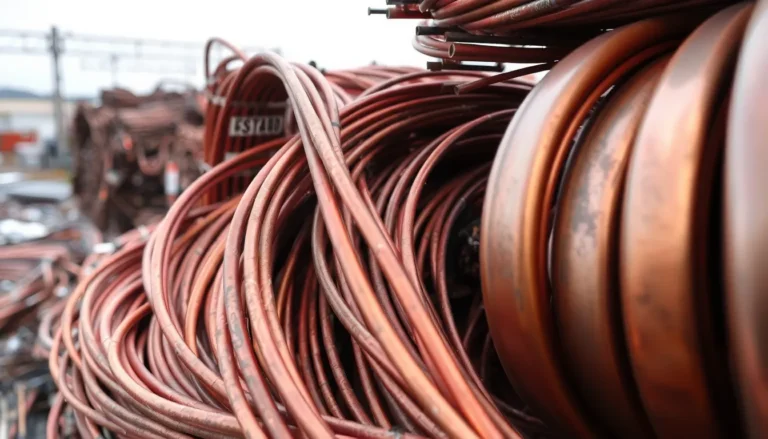In a world where energy bills can feel like a second mortgage, energy-efficient technology swoops in like a superhero ready to save the day—and your wallet. Imagine cutting costs while saving the planet. Sounds like a win-win, right? From smart thermostats that know when you’re home to LED bulbs that shine bright without dimming your bank account, these innovations are changing the game.
Table of Contents
ToggleOverview of Energy-Efficient Technology
Energy-efficient technology encompasses various innovations that optimize energy usage. This technology significantly reduces electricity consumption by employing advanced methods. Smart thermostats exemplify this, adjusting heating and cooling based on user habits, which leads to lower energy bills.
LED bulbs represent another leap in efficiency. Compared to traditional incandescent bulbs, LEDs consume up to 75% less energy and last up to 25 times longer. Their long lifespan reduces the frequency of replacements, contributing to ongoing savings and less waste.
Home insulation techniques also play a key role. Proper insulation reduces heating and cooling costs by maintaining a stable indoor temperature. Effective materials may include spray foam, fiberglass, and reflective barriers.
Appliances marked with the Energy Star label meet strict efficiency guidelines set by the EPA. These products typically use at least 10% less energy than standard models. From refrigerators to washing machines, energy-efficient appliances deliver reliable performance while decreasing energy costs.
Renewable energy sources are gaining traction in this sector. Solar panels harness sunlight to generate electricity, offering a sustainable alternative to fossil fuels. Integrating solar energy into homes and businesses can drastically reduce reliance on grid power.
In commercial settings, energy-efficient technology enhances operations. Automated lighting systems and energy management software optimize usage in large spaces. These solutions not only lower energy expenses but also support corporate sustainability goals.
Overall, energy-efficient technology drives financial savings and environmental benefits. Adopting these innovations contributes to a sustainable future while providing significant cost reductions. Embracing energy efficiency helps address high energy bills consistently.
Benefits of Energy-Efficient Technology

Energy-efficient technology provides significant advantages, leading to both environmental and economic improvements. Innovations in this area not only cut costs but also promote sustainability.
Environmental Impact
Reducing energy consumption has a direct positive effect on the environment. Energy-efficient technology minimizes greenhouse gas emissions, such as carbon dioxide. By utilizing smart appliances, homeowners contribute to lower environmental footprints. Implementing renewable energy sources, like solar panels, decreases reliance on fossil fuels. Less energy usage translates into reduced strain on natural resources. Choose energy-efficient products to support biodiversity and preserve ecosystems. Enhanced insulation methods also prevent heat loss, minimizing waste. With each energy-efficient upgrade, individuals effectively participate in combating climate change.
Economic Savings
Cost savings present a compelling reason for adopting energy-efficient technology. Smart thermostats can reduce heating and cooling bills by up to 30%. LED bulbs consume 75% less energy and last significantly longer than traditional bulbs, impacting electricity bills favorably. Appliances that meet Energy Star standards guarantee at least a 10% energy reduction compared to non-certified models. Additionally, investments in energy-efficient technology often qualify for rebates and tax credits. Utilizing these technologies leads to lower utility bills, freeing up funds for other expenses. Over time, businesses benefit from automated systems that enhance operational efficiency, translating into substantial financial gains.
Types of Energy-Efficient Technologies
Energy-efficient technologies come in various forms, ensuring that both residential and industrial sectors benefit from reduced energy consumption and cost savings.
Residential Solutions
Smart home devices play a key role in energy efficiency at home. Programmable thermostats enable users to automate temperature settings, leading to savings of up to 30% on heating and cooling costs. LED lighting provides a more sustainable option, consuming up to 75% less energy than traditional bulbs. Energy-efficient appliances, certified with the Energy Star label, utilize at least 10% less energy compared to standard models. Insulation improvements, such as spray foam and fiberglass, help maintain comfortable indoor climates and reduce energy expenditures.
Industrial Applications
In industrial settings, energy management systems optimize overall energy use, identifying inefficiencies. High-efficiency motors contribute significantly by using up to 8% less energy than standard options. Automated lighting controls adjust to occupancy levels, minimizing energy waste. Additionally, energy recovery systems capture waste heat, converting it for use in production processes and increasing overall energy efficiency. Implementing these technologies can lead to substantial reductions in operational costs while enhancing sustainability initiatives.
Transportation Innovations
Transportation advancements focus on reducing fuel consumption and emissions. Electric vehicles (EVs) offer a clean alternative, often using 60% less energy than conventional gasoline-powered cars. Hybrid models combine electric and gasoline engines, achieving better fuel efficiency. Public transportation systems, powered by clean energy sources, also enhance energy efficiency by reducing the number of individual vehicles on the road. Innovations in aerodynamics and lightweight materials further optimize vehicle design, resulting in improved fuel economy and a smaller carbon footprint.
Challenges and Limitations
Energy-efficient technology faces several challenges that can hinder its widespread adoption. Initial costs for implementing such technologies often deter potential users. Many individuals and businesses hesitate to invest in energy-efficient appliances and systems, even though long-term savings justify these expenses.
Limited awareness also plays a significant role in adoption rates. Consumers may not fully understand the advantages of switching to energy-efficient options, leading to missed opportunities for savings. Education campaigns can bridge this gap by informing users about technologies like smart thermostats and LED bulbs.
Technical limitations can impact efficiency gains. Smart devices require reliable internet connections to function optimally. In areas with poor connectivity, their benefits diminish. Similarly, some energy-efficient appliances might not fit specific household needs, leading to reduced efficacy or dissatisfaction.
At times, regulatory barriers arise, complicating the installation of renewable energy sources. Local governments may implement strict zoning laws and additional permits, complicating access to technologies such as solar panels. These regulations can stall progress toward greener energy solutions.
Moreover, compatibility issues often occur when integrating new technologies into existing systems. Older homes may lack sufficient infrastructure to support modern energy-efficient appliances, requiring significant renovations. These compatibility challenges can deter users from making necessary upgrades.
Market saturation poses another hurdle. A wide variety of energy-efficient products exist, making it overwhelming for consumers to choose the right options. Simplified decision-making tools can assist in guiding users toward the most suitable choices while still promoting energy savings.
Ultimately, despite these challenges, the continual evolution of energy-efficient technology offers potential for overcoming these barriers. As innovations emerge, increased accessibility and declining costs could enhance adoption, helping to combat high energy bills and promote sustainability.
Future Trends in Energy-Efficient Technology
Emerging technologies are shaping the energy efficiency landscape. Smart grids, for instance, enable more efficient energy distribution, reducing waste and enhancing reliability. Energy storage solutions like advanced batteries support renewable energy integration, making solar and wind power more viable.
Artificial intelligence (AI) provides significant advancements in optimizing energy consumption. Integrating AI into smart devices allows real-time energy monitoring, enabling users to adjust usage based on predictive analytics. Such systems can improve overall savings by identifying patterns and recommending changes.
Research into sustainable building materials is gaining momentum. Innovations in materials, such as high-performance insulation and energy-efficient windows, enhance thermal performance. These improvements lead to greater energy savings in both residential and commercial buildings.
Electric vehicle (EV) adoption is on the rise. EV sales surged over 40% in the past year, as consumers seek greener transportation options. Charging infrastructure expansion boosts convenience and further encourages this transition.
The growing focus on energy-efficient heating and cooling technologies is noteworthy. Heat pumps, for example, offer significant efficiency over traditional systems, consuming up to 50% less energy. Investing in these technologies supports both financial and environmental goals.
Smart home integration continues to evolve. Devices that communicate with each other create comprehensive energy management systems. Such systems foster an ecosystem where users can make informed decisions about their energy use.
Access to information is crucial for encouraging wider adoption. Education initiatives highlighting benefits and available incentives can drive consumer interest. With more awareness, individuals and businesses may take proactive steps towards energy efficiency.
Each of these trends signifies a shift towards a more sustainable energy future. The convergence of technology and consumer demand propels this shift, promoting both energy savings and environmental stewardship.
Energy-efficient technology is more than just a trend; it’s a vital component in the quest for sustainability and cost savings. By embracing innovations like smart thermostats and energy-efficient appliances, individuals and businesses can significantly reduce their energy consumption and expenses. The ongoing advancements in this field promise not only to enhance efficiency but also to support a greener future.
As awareness grows and technology evolves, overcoming the barriers to adoption becomes increasingly feasible. The shift towards energy-efficient solutions reflects a broader commitment to environmental stewardship and economic responsibility. By making informed choices today, everyone can contribute to a sustainable tomorrow while enjoying the financial benefits that come with it.




